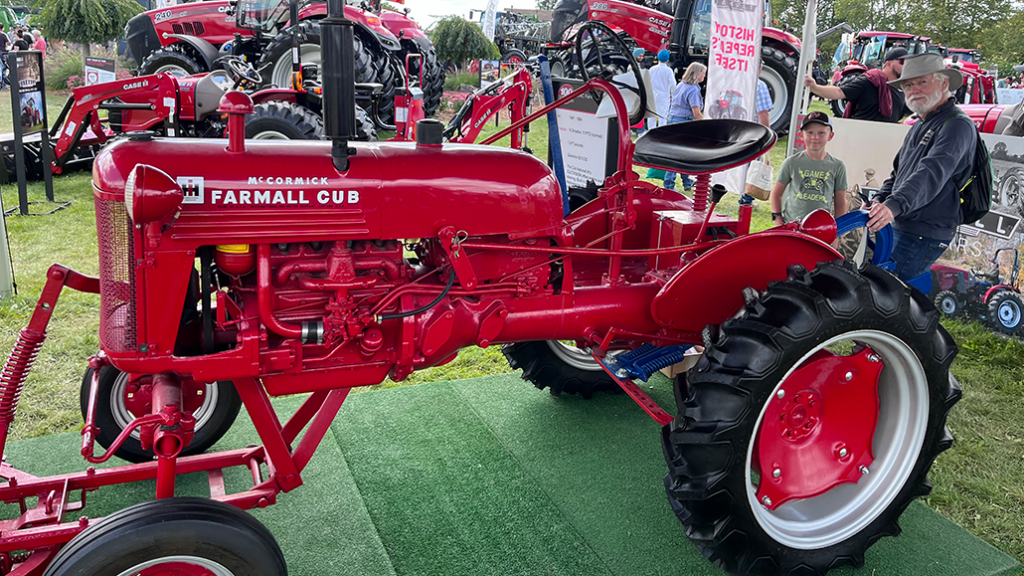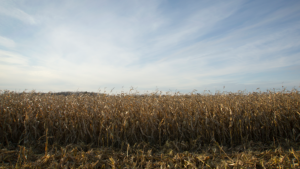As seen at the show
CANADA’S OUTDOOR FARM SHOW MARKS 30 YEARS

CANADA’S OUTDOOR FARM SHOW (COFS) has been showcasing the latest in agriculture technology for 30 years — and the 2023 show was no exception. With three full days of equipment demonstrations, crop plot displays, special events, and more than 650 exhibitors, there was something for everyone at this year’s show held September 12 – 14 at the Discovery Farm, Woodstock.
AGRICULTURE CHAMPIONS HONOURED
On opening day, the show’s director and one of the founders of Canada’s Outdoor Farm Show, Doug Wagner, was honoured with the unveiling of ‘Doug Wagner Way.’ Running along the front of the show — the social hub near the Ducks Unlimited Pond, the Alltech Deck, and the Adama Lounge, the location of many of the show’s festivities — the street sign that bears his name will be a lasting legacy for Wagner, who was also inducted into the Ontario Agricultural Hall of Fame in 2023, recognizing his lifetime commitments to Ontario agriculture and COFS.
Also honoured at the 2023 COFS was former Ontario Soil and Crop Improvement Association (OSCIA) executive director Andrew Graham, recipient of the L.B. Thompson Award administered by the Soil Conservation Council of Canada (SCCC).
The L.B. Thomson Award recognizes individuals or organizations that have made a significant regional contribution to soil health and conservation and was established in 1987 in honour of Leonard Baden Thomson. Thomson was one of a group of agrologists who played a key role in developing soil conservation practices that minimized the effects of severe wind erosion that plagued the Prairies in the 1930s.
Graham, whose career in agriculture stewardship has spanned 43 years, worked for OSCIA for 33 years, eight years as executive director until his retirement earlier in 2023.
“Andrew Graham embodies the spirit of the L.B. Thompson Award through his lifelong work promoting soil health and conservation in Canada,” says Ian Boyd, chair of the SCCC. “His contributions to building practical approaches to improving soil health reached thousands of farmers in Ontario and across Canada, enabling them to take action to maintain and improve the health of their soils.”
2023 INNOVATION PROGRAM
At an awards ceremony on September 11, Canada’s Outdoor Farm Show presented its annual Innovation Program awards. Supported by the Ontario Ministry of Agriculture, Food and Rural Affairs, the Innovation Program gives agricultural businesses the opportunity to show off ideas and products that are new to the market in five categories: Agronomics, Business Solutions, Environmental Sustainability, Equipment, and Livestock.
The 2023 winners include:
• A&L Canada Laboratories Inc.: AL-Bio7 in the category of Agronomics
• Agrilog: Agrilog Platform in the category of Business Solutions
• Clean Works: Clean Flow in the category of Environmental Sustainability
• Ag Leader Technology: TurnPath in the category of Equipment
• VETSon: VETSon Veterinary Virtual Healthcare for Farm Animals in the category of Livestock
Winners of the 2023 Innovation Program exhibited at COFS in the OMAFRA Innovations Tent alongside other innovative agricultural companies. For Agrilog, a Quebec-based business specializing in grain storage management and automation solutions, exhibiting at COFS and winning the Business Solutions category in the Innovation Program was an opportunity to get their products and services out in front of potential new customers.
“We are hoping to find our first customer in Ontario to pilot our Agrilog platform,” says Mathieu Phaneuf, founder and president of Agrilog.
WHAT’S NEW?
Seeing the latest in agriculture innovation up close and in action is a highlight of COFS and gives farmers a chance to talk to experts and learn more about ways to integrate new technology on their farms.
In addition to the newest tractors, combines, planters, manure spreaders and more that farmers come to see, COFS also offered attendees the opportunity to see cutting-edge technology in action.
Haggerty AgRobotics founder and president Chuck Baresich says he’s always been the guy to have the newest and coolest technological toys, and this year, he brought nine of them to COFS. As an early adopter of autonomous equipment, Haggerty AgRobotics is bringing Ontario farming into the 21st Century, trialing North American and European-designed and built autonomous equipment on farms across Ontario. This year, Haggerty AgRobotics rented 18 robots to farmers, up from three just two years ago. Next year, they hope to have 30 robots on farms across the province.
During daily demonstrations, Baresich gave a running commentary about the robots, from the teeny tiny Naio Oz to the Zamboni-sized Nex La Chevre, to eager groups of farmers and attendees who watched on as the autonomous equipment worked away in a demonstration plot across from the main show site.
While the robots on display may have resembled something out of a science fiction movie, Baresich says to think of them just like any other piece of equipment you’d use on the farm – each designed to do a specific task.
“Most of our robots are simply autonomous tractors. If you think of them as a tractor first… then you can run any kind of implement just like on a lawn mower or a tractor,” he says.
While many of the robots on display were more suited to smaller market garden-sized farms and horticultural crops, Baresich says several models they have trialed show promise for larger-scale grain farms.
He points to the Danish-made Robotti as an example. Differing from the other robots, which are electric-powered, the Robotti is diesel-powered, designed to run autonomously for 60 hours on a tank of fuel. It has a regular three-point hitch and can accommodate regular hydraulic attachments, which means it has a little less of a learning curve than some of the other robots in the Haggery AgRobotics fleet.
“What’s interesting about the Robotti is that it is not a big of a transition. So, some who have looked at it say, ‘it’s got a diesel engine, it has regular hydraulics, a regular three-point hitch… maybe not as much to learn,’” says Baresich.
The farmer who used the Robotti in the 2023 season used it to plant corn and sugar beets and will try a strip-till attachment in the fall.
Ultimately, Haggerty AgRobotic’s goal is to continue growing its fleet of robots and work with farmers, users, and manufacturers to address the challenges and limitations they come across as they are trialed in various Ontario conditions, soil types, and weather.
“What we’re trying to show for farmers is [the robots] working in real-world conditions, not just test plots. It’s a lot of trial and error,” says Baresich.
Find out more at www.haggertagrobotics.com.
UP IN THE AIR
While drones for agricultural use are not necessarily new, new and expanded applications for on-farm use make them more appealing for the average farmer, says Felix Weber, president and agriculture specialist at Ag Business and Crop Inc. in Palmerston, Ontario.
Weber hosted daily drone flying demonstrations for COFS attendees, drawing large crowds interested in learning more about how the technology can be used on their farm. A self-described early adopter of technology, he’s been flying drones since 2011.
As a mapping tool, he says drones did not really take off in agriculture, and beyond a fun toy that could take some cool photos, many farmers did not see a return on investment. But as technology evolves — and the ability to use drones for more uses such as in-crop seeding and fertilizer application — he sees more and more farmers’ interest being piqued by drones. Potential changes to the Pest Management Regulatory Agency’s (PMRA) rules, which would allow pesticides to be sprayed via drone, could open up the market even more. (Currently, PMRA has authorized only a small number of biological larvicides for drone application.)
Weber encourages farmers interested in using a drone to do their homework and get the necessary training and licenses.
“Buy a small, cheap drone to get used to flying,” he advises. “You can’t buy a drone today and start tomorrow; there is a learning curve.”
Find out more at www.agbusiness.ca.
LOOKING BACK
While most exhibitors at COFS were looking ahead to the future, seven-year-old Caleb Dickie, son of James and Janine Dickie of Whitechurch, Ontario, was eager to learn more about the Farmall Cub tractor on display at the Case IH booth.
Caleb’s Grandpa, Walter Dickie, explained that he grew up using the 1949 model on his home farm in Whitechurch. His brother, William Dickie, still has that same tractor.
2023 marks the 100th anniversary of Farmall tractors, launched in 1923 as the “one for all” farm implement.
“In 1923, we set out to design a tractor that could replace horses, and today, our Farmall still serves as the workhorse on farms across the globe,” says Scott Harris, Case IH global brand president, in a news release. “Generation after generation, Farmall has been a symbol of modern farming.”
To mark the 100th anniversary, Case IH has launched two new Farmall models, the Farmall 90N and 120N.
Caleb Dickie, who says he wants to be a ‘farmer and a wrestler’ when he grows up, enjoyed learning more about the past but was also excited, in addition to getting a day off school to visit the show, to see new and modern equipment like skid steers and tractors on display and to kick a few tires along the way. •



















